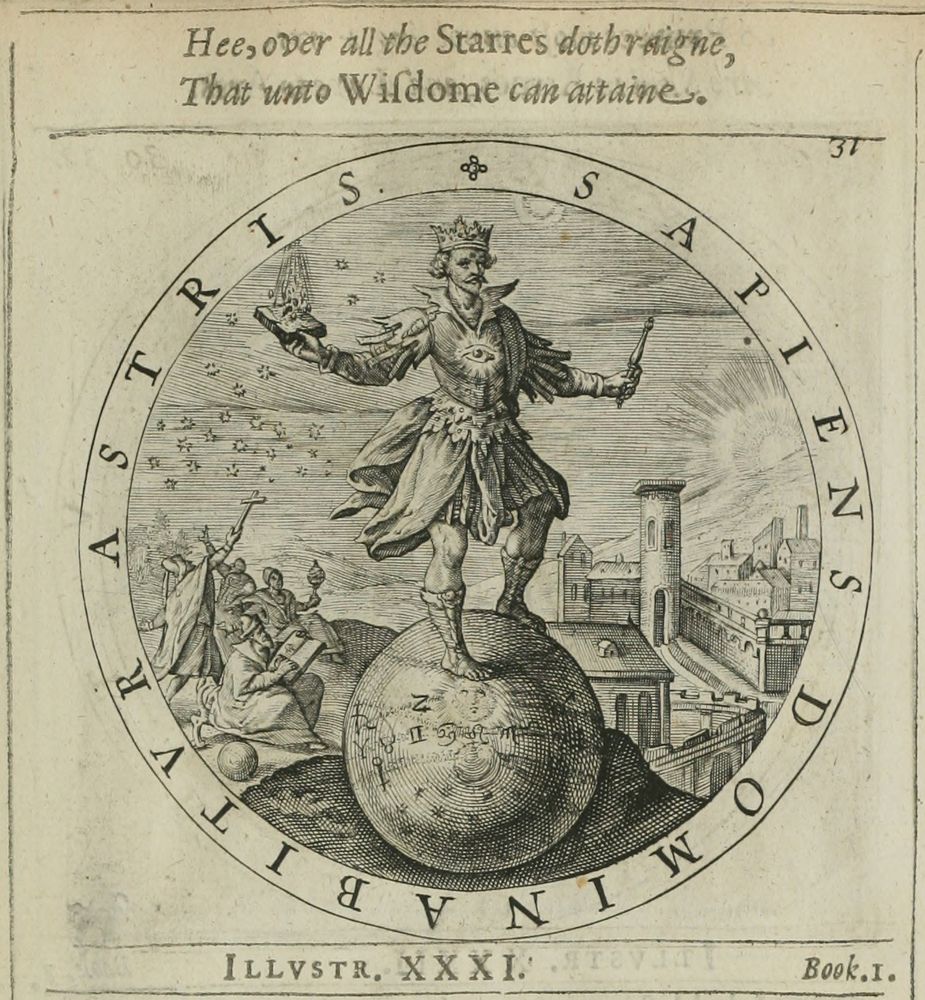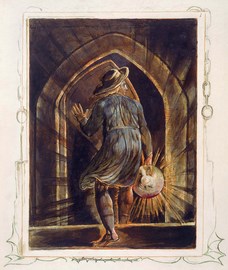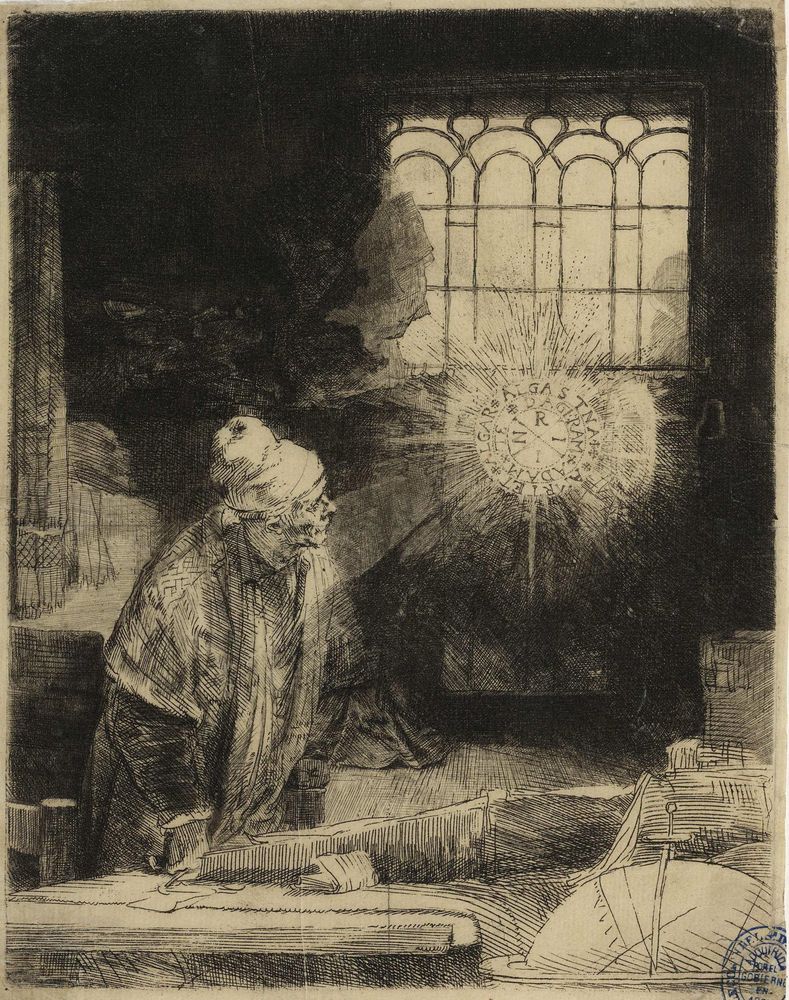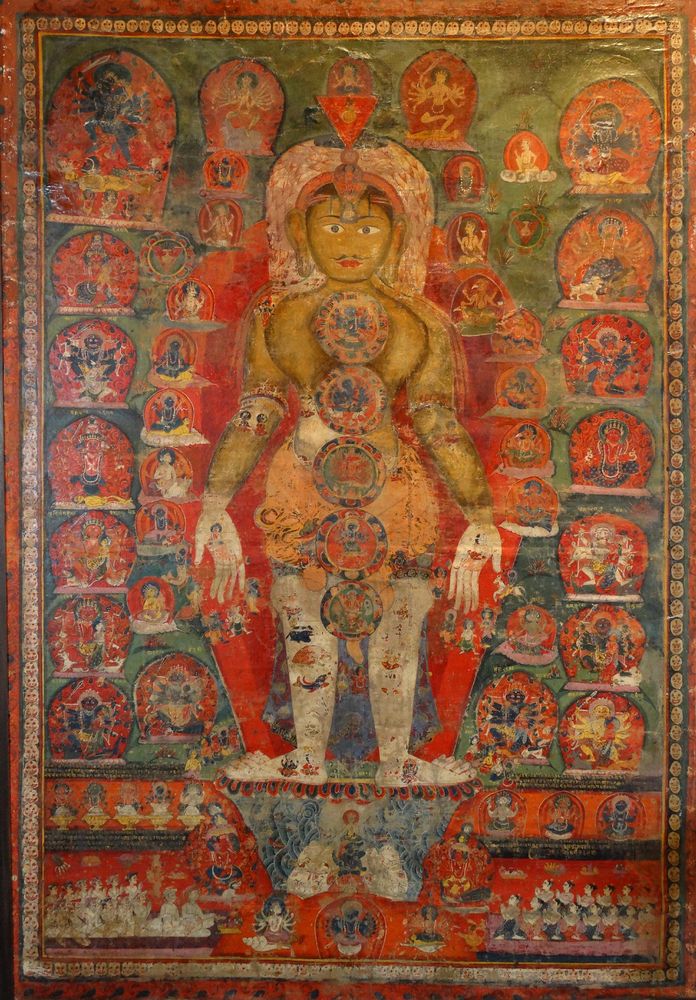
Esotericism
ˌɛsəˈtɛrɪsɪzəm (UK) / ˌɛsəˈtɛrəˌsɪzəm (US) — masc. subst.
 ENG▼
ENG▼|
[Esotericism (Esoterosophy)] ► Sapience into the vital and amorous processes of the absolute: its constitution and its laws, its origin and its end. This sapience is esteemed as being the purpose of Humanity, the essence of all religions, and is expressed hermetically through rituals, symbols, and nature itself. [Esotericism (Esoterology)] ► A set of reserved knowledge, formalized into various theoretical and/or practical systems, transmitted orally by initiates (in a profane, sacred, or gnostic sense) to candidates deemed intellectually, morally, and physiologically capable. Stemming from this anthropological structure, this results, the formation of an elite (within a society, religion, corporation…) and the practice of secrecy, a mindset that is recurrently found throughout human history. [History (of Western ideas)] ► Discipline whose object is esotericism. It emerges from the mystico-magical roots of religions (mainly egyptian, assyrian-babylonian, and hyperborean shamanic) in the mystery cults, appears distinctly with pythagoreanism, and then especially with neoplatonism. It begins to take shape with christian hermeticism in the classical middle ages and finally emerges during the renaissance, in the context of the Platonic Academy of Florence, which brings together its main branches. It ultimately establishes itself as a distinct current in the l.XVII – e.XVIII. | |||||||||||||||||||||||||||||||||||||||||||||||||||||||||||||||||||||||||||||||||||||||||||||||||||||||||||||||||||||||||||||||||||||||||||||||||||||||||||||||||||||||||||||||||||||||||||||||||||||||||||||||||||||||||||||||||||||||||||||||||||||||||||||||||||||||||||||||||||||||||||||||||||||||||||||||||||||||||||||||||||||||||||||||||||||||||||||||||||||||||||||||||||||||||||||||||||||||||||||||||||||||||||||||||||||||||||||||||||||||||||||||||||||||||||||||||||||||||||||||||||||||||||||||||||||||||||||||||||||||||||||||||||||||||||||||||||||||||||||||
| Etymology |
■ ? Ind.Eur. : *h₃yebʰ- {go inside, penetrate, copulate} ↳ Grc. : ἐσωτερικός (ésōteriκós) {from the inside} (ultimately from the ionian adverb/preposition "esô" {in})
| ||||||||||||||||||||||||||||||||||||||||||||||||||||||||||||||||||||||||||||||||||||||||||||||||||||||||||||||||||||||||||||||||||||||||||||||||||||||||||||||||||||||||||||||||||||||||||||||||||||||||||||||||||||||||||||||||||||||||||||||||||||||||||||||||||||||||||||||||||||||||||||||||||||||||||||||||||||||||||||||||||||||||||||||||||||||||||||||||||||||||||||||||||||||||||||||||||||||||||||||||||||||||||||||||||||||||||||||||||||||||||||||||||||||||||||||||||||||||||||||||||||||||||||||||||||||||||||||||||||||||||||||||||||||||||||||||||||||||||||||
⟴IntroductionI. Scope and redirections ■ Inasmuch as esotericism (and its related subjects) is decidedly the primary focus of this encyclopedia, which aims for a certain level of exhaustiveness, this entry will strictly confine itself to characterizing this term, while particularly attending to its meaning, fundamental sense, and exposition. ↳ Regarding history and doctrines, concepts and representations, personalities and organizations, works and studies, and finally, any other subject that presents more or less singularities and specificities, please refer to the various sections of this encyclopedia. ◆ Except for the entry tables of the thirteen sub-sections that make up the main body of our project, we immediately draw attention to, starting from the sub-section Mementos, certain documents whose subjects seem to us essential for gaining a comprehensive theoretical overview : ↳ a. For the historical aspect, 𝕍 ntb. the memento The Major Events of Western Spirituality, which specifically aims to chart the history of Western spirituality, with a natural focus on esotericism. However, it should not be overlooked that, unlike technical fields, the historical discipline cannot provide deeper insights than the convenience afforded by chronological landmarks. ↳ b. A thematic guide is at your disposal to navigate in a reasoned and intentional manner through the various sections of the encyclopedia (and thus through the theme of esotericism itself), as well as to benefit from methodological suggestions. ↳ c. The two organigrams presenting the Western spiritual currents in typological order and the non-Western spiritual currents in typological order should also be relevant for obtaining a comprehensive view of the conceptual links and historical articulations that connect the various spiritual currents. ↳ d. Finally, regarding reference documents that can serve as a primary tool, the tables of French-language publishers specializing in esotericism, that of French-language bookstores specializing in esotericism, that of academic journals, and finally that of initiatic journals should also provide several non-negligible and immediately operational documentary resources. II. Clarifications surrounding a problematic term ◆ If the adjective "esoteric" dates back to 166 (Lucian, Vitarum Auctio), the noun "ésotérisme" is only from 1828 (Matter, Histoire du gnosticisme Vol.2,p.83). Until the m.XX century, the available definitions for this noun were quite vague or even confusing. It is true that, encouraged by media and commercial treatments, due to the lack of a methodical definition, clear lexical distinctions, and precise historical milestones, the term designates, for both the general public and still too many academics (and sometimes even some esotericists themselves), a heterogeneous, disordered, vague, and ultimately vaporous conglomerate of conceptions and methods framed by an affectation for the mysterious and the fantastic. Moreover, characteristic elements of esotericism are present at very diverse levels of numerous civilizations, in varied and often hidden forms, which does not facilitate their distinction or identification. However, esotericism, a cultural fact, is constituted by a bundle of natural facts, and then develops into a weltanschauung. It is thus truly a domain in its speculations, a discipline in its praxis, and a current of thought once placed back into the flow of history. ↪ However, esotericism, due to its very nature, generates fantasies and misconceptions, and this, along three main axes: ● a. Interdisciplinarity. First, through its natural disposition and its will to synthesize, esotericism rejects watertight systems and repudiates taxonomies. It is an interdisciplinary field where theology, philosophy, and psychology, art, and sciences converge. Consequently, it overflows into these fields in many authors, sometimes in an occult or underground manner, and willingly imprints fragments of its weltanschauung. Moreover, its investigative methods, strongly heuristic, are as subjective, mystical, and faith-based as they are objective, empirical, and pragmatic. Essentially, they culminate in the phenomenon of vision. Except for certain ideological biases, this is the first reason why esotericism, as a whole, was difficult to discern and therefore study for intellectuals and academics(1) until the fh.XX, where structural similarities between thinkers were finally recognized and accepted. ● b. Typological confusions. It must also be added that this "conglomerate of conceptions and methods" is frequently perceived as dubious, particularly in light of the zeitgeist, imbued with the epistemology of modern science. Moreover, these suspicions are reinforced if, adding to the ignorance of the object and methods of esotericism, one takes as a reference the transverse and unequal content of neo-occultism of the XIX century or, what is more significant and legitimate, that of the esotericizing new spiritualities from the 1970s (notably Wicca and new-age). This sentiment is all the more affirmed if one examines the content, even later, of personal development. These approaches are all, to a large extent, inscribed in a psychologizing (or superstitious) and commercial (if not interested) approach and naturally incite polemical positions. And consequently, these approaches cannot be representative of esotericism, either in its real content or in its development within the history of ideas. ↳ Be that as it may, it is opportune to note that if occult practices rooted in popular superstition and issuing from degenerate paganism existed during the Middle Ages, most esotericists today are connected to the syntheses and speculations made from the Renaissance. They take ntb. root in Ficin and then Pic de la Mirandole, who, from Christianity and the various currents that flourished in Eastern Mediterranean, elaborate speculations and questionings in the field of secondary causes and intermediate entities. This domain was indeed then neglected by scholastic theology dominated by Aristotelianism. Now, from a speculative point of view — and thus distinguishing itself from the theological or mystical approach — the intermediate world (founded by the union of God’s call and man’s response) constitutes for the esotericist the summit of the divine design and elaboration, the eschatological completion of their common work, which they envision thus according to a three-dimensional schema(2). Since the term "esotericism" did not yet exist, the expressions philosophia occulta or philosophia perennis were used by these humanists. Their project was to reform official teachings while relying on ancient and medieval traditions: pythagoreanism, neoplatonism, and alexandrian hermeticism, alchemy, astrology፧, magic, and kabbalah. ● c. Gnoseological inadequacies. Finally, the third source of misunderstanding lies in the rational categories through which esoteric thought evolves: it employs, in part (and its most august part), spontaneous, archaic, principial, universal, and omnidirectional logical articulations, found in children, primitives, the insane, or poets(3), differing only in that esotericism claims to illuminate, vectorize, and edify these processes. Pragmatically prioritizing the operational processes related to mysteriosophy, esoteric thought finds its raison d’être and finality in the illumination of spirits and the deliverance of souls. Thus, esotericism constitutes the horizon of philosophical reflection: it deems logical-discursive operations and the idea of linear causality insufficient, the law of excluded middle disproportionate, and finally, the notion of univocity, inadequate from a practical perspective. Esotericism does not do the opposite of rationality but the contrary: it seeks — in a word — to reveal and explicate the process of catasterisation and ultimately manifest the hidden sun within the soul of Man. ↳ Indeed, by its very nature, which is a constant will to return to the principle and a questioning and research posture, particularly with regard to tradition(4), esotericism goes against the temporal process of biological evolution and thus, against everything that results from it. It is thus fatally in a marginal position with regard to society, its modes, and its knowledge(5). Ontologically, it rejects the limits of common sense imposed by the habits derived from the corpus of constituted knowledge, estimating, through an imaginative dynamic that questions acquired knowledge, that even if the premises of a reasoning are correct, this does not eliminate the risk of subsequent error(6). He makes the Buddha’s words his own: ↳ However, diverging from the norm, esotericism is no less deeply embedded in the human adventure. On the one hand, the intuitions of esotericism were the metaphysical starting point of philosophies whose structure presents isomorphisms with tradition: e.g. Spinoza and kabbalah, Berkeley (Siris) and alchemy፧, Jung and esotericism in general. On the other hand, having the characteristic of being able to adapt to many modes of thought, esotericism, going beyond the framework and acting as a catalyst, stimulates reflection and regularly interferes with ideologies and politics, artistic and engineering culture throughout history: a large number of discoveries, innovative ideas, "first times," and new paths(8) were indeed operated by esotericists or influenced by esotericism. Furthermore, esoteric thought, latent in the human psyche, naturally incubates in popular culture, which constitutes one of its matrices. It thus regularly re-emerges in a spontaneous and unexpected manner in the vast domain of folklore, which, although unstable and mirage-like, constitutes a privileged terrain of research for the esotericologist.  👁 👁
Œuvre Name : Doctor Faustus under study (The Alchemist) Author : ? Rembrandt van Rijn Date : ? 1652 Type : Engraving on paper Source : National Library of Spain 

↪ Thus, even td., for collective consciousness, esotericism, as a principle, essentializes itself through a syncretism of its various theoretical and practical branches (occultism, magnetism, divination…) and remains, at best, in an interval and precarious position. Most authors, naturally showcasing their own understanding and viewpoints(9), maintain the confusion: (a.) by not giving the same semantic content to the words used, (b.) by systematically associating it with a counterculture, which, sociologically, does not constitute one of its specificities, (c.) or by reducing esotericism to one of its parts(10). ↳ It is, however, important that esotericism should be distinguished from theology first and philosophy second (and to a lesser extent, from science and art), legitimate and a priori more delicate distinctions insofar as the interpenetration between these domains occurs at several levels, ntb. historical, conceptual, and epistemological(11). It suffices to mention that the pre-Socratic Pythagoras, to whom the invention of philosophy and the word itself is attributed (via the famous anecdote of Heraclides Ponticus cited in Iamblichus Life of Pythagoras XII, and Cicero Tusculanae Disputationes V:3-4), is also considered the oldest Western esotericist (the figure of Orpheus, who precedes him, is lost in mythical times, and Zoroaster, although equally respected, is an Oriental). ⟴DescriptionI. Key objectives ► Regarding its objectives, esotericism can be defined concisely as the search for understanding the meaning of the cosmos and the attainment of psycho-spiritual fertility that results from it, through the means of good fortune. This cosmological approach is considered to be the nature and dignity of Humanity itself. It is characterized by a concern for authenticity and depth and involves an attitude that is both introspective and extrospective. It leads, on the metaphysical and ethical planes, to actualizing the place of Humanity in the cosmos. Elevated to the height of its project and formulated metaphysically, this search culminates in the desire to simultaneously grasp: definitive salvation through the supreme unity of transcendence and the enjoyment of progressive and infinite evolution in the dual immanence. Thus, esotericism, as a teaching, is a set of knowledge and practices of initiatory and soteriological intention. 

Œuvre Name : Sapiens dominabitur astris Version : UIUC Author : George Wither Date : 1635 Type : Engraving on paper Source : in A collection of emblemes, ancient and moderne 

↳ As a result of this approach, we can see, to begin with, that any esoteric formulation systematically generates, in the long run, accounts of (a.) the subtle structure of the universe, the forces and influences that govern it, and the impressions they suggest to the phenomenal world, (b.) the nature and place of humanity within this universe, particularly through the exposition of its occult anatomy, and finally (c.) the relationship established between the two(12). ↪ As a consequence, esotericism fundamentally deals with sacred anthropology, self-knowledge(13) and the edification of Man (first spiritual, then physiological). From the esoteric perspective, the latter is often considered inauthentic, incomplete, or degenerate from the standpoint of consciousness and power, as it is momentarily diverted from its true destiny, under the yoke of normally inferior powers. The esotericist thus sets as their goal to align their microcosm, personal anthropocosm, with the ideal cosmic macrocosm, the αρχάνθρωπος (archánthropos). Or better, to allow a synthetic and harmonious superposition (not a radical fusion, which would be mystical indifferenciation) of all parts of the cosmos (of which humanity and nature are strata) with God. This, so that, adequately superposed, these different parts focus — like so many lenses — the original light, which, consubstantial with the divine, is grasped as the concentrated essence of God’s transmutative power. ↳ Ultimately, and like any other discipline, esotericism in its total and ideal sense can only be truly apprehended by a master in this domain: the adept; who, through the exemplary intermediary of God, has been initiated into the secrets of creation. It is indeed the will of God, transcribed in the laws of said creation, which manifest, so to speak theophanically and from the human perspective, through the tradition. The esotericist, through various approaches peculiar to them, receives this tradition as a word or language. They attempt, through it, to understand, follow, and practice these laws by means of a set of paradigms and axioms. This, with the aim of accelerating, in a necessary and decisive manner, this process of superposition — of communion in the moral sense — while avoiding the errors and unnecessary sufferings rendered by the conscious process of which they hold the power. II. Manifestations ► In the esoteric perspective, esotericists, or ideally adepts, can generate philosophies, religions, or currents of thought, whose esotericism, more or less explicit and which is their raison d’être, is underlying(14). It is considered as constituting the vital core as well as the secret part reserved for initiates (opposite of the profanus {outside the temple}), mysteriously unknowable in the absolute but magically penetrable(15). Like all currents of thought, esotericisms will, over time and with human displacements, interweave, interpenetrate, or be absorbed, in whole or in part, by other currents, esoteric or not. In general, for the esotericist, the esoteric content becomes impoverished through repetition and the initiatory transmission is interrupted unless another initiate comes to regenerate, through a new interpretation, the current in the process of sedimentation. If not, the current degenerates until it disappears. However, new esoteric currents, more or less powerful, spontaneously and ceaselessly appear over time (although at different intervals), reformulating and adapting the doctrine according to the era and place, since it is estimated that esotericism is the fundamental drive of the homo religiosus: their appearance is, for him, a matter of ontological fatality. ↪ At a global level and according to the scale of humanity, esotericism, manifested in the tradition, constitutes the repository of human wisdom accumulated over the ages. It is apprehended as indicating the behaviors and ways of life, disciplines and processes allowing for consciousness(16) and mastering internally, gradually, the forces of the cosmos(17). This internal mastery manifests at the conceptual level as a metaphysical awareness of the links that unite humanity on one hand, the cosmos and nature on the other, as well as the entities that inhabit them. Hence, in esotericism, the themes of perception (particularly vision) and knowledge are permanent. ↳ It is due to this conception that the esoterosopher is committed to transhistorical research(18), transarchaeological (e.g. Atlantis) or translinguistic (e.g. the works of Olivet) rather than historical, archaeological, and linguistic considerations, which, if not necessarily excluded from the esotericist’s field, will only concern the esoterological or esoterographic activity in their own right. It is essential not to confuse these two orders if one wishes to avoid numerous misunderstandings regarding the subjects, intentions, methods, and goals of esotericism. Thus, from a mythical or occultist perspective, esoteric knowledge is estimated to be ancient, antediluvian, or even dating back to the origin of creation. This knowledge is also hidden from the majority of humanity and only accessible to initiates, who are its guardians. Esotericism therefore asks humanity to embark on an inner quest to discover within themselves and/or in nature a treasure, generally apprehended as being God himself, this discovery signifying then salvation. III. History and linguistics of the word ■ For this chapter, we are largely indebted to the work of Riffard in L’Ésotérisme and Ésotérismes d’ailleurs. ◆ Regarding the historical and linguistic background of the word 𝕍 the chapter Platonism and Aristotelianism in Memento The Great Events of Western Spirituality. ► Several morphological derivatives of the word "esotericism", enlightening for vocabulary and conceptualization, were forged over time. Let us primarily mention : a. Disciplines : ⟴↳ Esoterosophy: Constructed like "theosophy". Esoteric approach to esotericism. Focuses on spiritual content, concordances, and meaning (e.g. Proclus, Ibn Arabi, Hall, Schwaller de Lubicz, Corbin…). ⟴↳ Esoterology: Constructed like "ethnology". Study of esotericism in general, aiming to be objective and impartial, conducted to highlight its structures and experiences through comparison, synthesis, and interpretation (e.g. Iamblichus, Papus, Guénon, Steiner, Eliade, Jung…). ⟴↳ Esoterography: Constructed like "lexicography". Documentary and critical (descriptive, analytical, and evaluative) approach to specific esotericisms (voluntarily or not, authentically or improperly) i.e. limited in space-time. Can be office-based, field-based, laboratory-based, or oratory (using esoteric methods). Draws on auxiliary sciences such as sociology, linguistics, history, statistics, or archivistics… (e.g. Bouché-Leclerc, Cumont, Avalon, Festugière, Tucci, Faivre…). ◆ It is essential to know the advantages and disadvantages of each discipline in order to be able to employ them appropriately depending on the perspective from which one wishes to approach and the approach one wishes to apply. It is equally important to know which discipline an author is operating within. Esoterology and esoterography are obviously related to the major currents/religions of their time (Christianity, humanism, rationalism…) and to the more or less sectarian schools of thought to which the individual practitioners may belong (Freemasonry, psychologism, scientism…). Esoterosophy, on the other hand, is primarily subjective, and, while it does not escape cultural conditioning through the individual, it is based on intentions and methods that truly make sense in the domain of esotericism. These disciplines are not, of course, impermeable, and the practice of one does not preclude the other. Thus, the same person can practice two or all three disciplines simultaneously(19), in the same(20) or multiple works, over a period or throughout their entire activity. The examples given to illustrate each discipline are therefore only indicative. e.g. perennialists are both esoterologists, esoterographers, and additionally conditioned by their school of thought; Clement is an esoterographer and esoterosopher, primarily conditioned by Christianity; etc.. ↳ ORAEDES, while making sure to avoid the influence of excesses from currents and the conditioning of schools — ntb. by simply reporting all points of view —, is primarily and intentionally esoterological but also extensively employs esoterosophy and esoterography when it seems appropriate or with a concern for exhaustiveness. b. Concepts : ↳ Esoterumen: Constructed like Aristotle’s "theologoumenon" (Riffard indicates a source in Plutarch, Moralia 421d, but we couldn’t find it). Universal esoteric, idea or common action shared by all initiates. ↳ Esotereme: Constructed like Levi-Strauss’s "mytheme". A minimal unit with esoteric value. ↳ Esoterica : Construit comme orphica, hermetica etc.. Recherches, ensemble d’ouvrages ou matières relatives à l’ésotérisme. c. Qualifiers : ↳ Esoterizing: Said of something that shows esoteric tendencies, whether in form or substance. Many personalities 🗎⮵ treated in this encyclopedia are more esoterizing than esoteric. There is also the term "pre-esotericism" to distinguish limited approaches of certain mystics (e.g. Hildegard), who, by dint of "bathing", develop conceptual islands, but who have not yet entered into a relationship with them in such a way as to constitute a science, cannot be called esotericists. ↳ Ésotéricisme (Esoteric exclusivism): Attitude refusing access to non-initiates to certain knowledge, either by condemning their access through occultation (e.g. discipline of the secret), or by making them incomprehensible without a key (e.g. argot, cryptography, symbolism…). In a broader sense, this esotericism can be involuntary, as in the case of a trade’s technical language. Dnc. with the factual hermeticism of esotericism. (Constructed with the same intentions as Guénon’s "theosophism": to free the term "esotericism" from its semantic degradation, which is the commonly accepted definition, and to isolate in this neologism an attitude that mimics appearances rather than the essential idea) 
↳ Pseudo-esotericism: Altered imitation, voluntary or not, of esoteric goals, intentions, and methods. Borders on charlatanism. ↳ Counter-esotericism: Reversal of esoteric values and symbols leading by definition to spiritual inertia and material destruction, both of humanity and nature. From an occult perspective, this ontological shift corresponds, from a psychological and subtle point of view, to an unnatural animic crystallization that affects a process of cementation instead of dendritization. From a metaphysical and spiritual point of view, it operates a downward autophagic replication instead of an ascending unifying fractalization. According to demonological indices, it tends to lead the body towards asmodeism, the soul towards diabolism, and the spirit towards mephistophelism. ◆ Closest correspondences to the word "esotericism" in different systems:
■ The purpose of this table is not to provide translations of terms whose lexical field could fall within that of esotericism, but rather to propose terms that signify it in their respective languages. These equivalents are more or less direct and integrated without necessarily structuring internal coherence within a single system based on the individual meaning of each term. ■ Terms with disputed etymology, for example تصوف (tasawwuf) {sufism} from Ibn Sharik, are not included in the table. ⟴TypologiesI. Typology of esotericism ► In an attempt to define the subject, a number of authors, first esotericists and then esoterologists, have tried to define and characterise esotericism. Although not all of these points are necessarily present at the same time, or to the same degree of importance or development, they must nevertheless come together in sufficient number to be able to define the contours of esotericism. Otherwise there is a risk of confusion with philosophies, mysticisms, occultism or simply religious systems. The most constant, universal and characteristic common points in esoteric currents of thought are : ● a. An opposition between the esoteric and the exoteric, the idea of an inner church uniting initiates, opposing the visible church of the temporal plane. The recourse to initiation as a mode of transmission allows one to burst into the other. This initiation operates, particularly, from master (individual or entity) to disciple through an uninterrupted initiatic chain (between God and the recipient). This transmission operates either through the direct intermediary of an occult force (containing an individualized portion of the law) or through the indirect (or filtered) one of hermesism. This initiation enables the initiate, fallen, incomplete, incorrect Man, to awaken to spiritual realities and form a gnosis, which, as a fusion of knowledge and faith, is a knowledge of the heart and allows him to become a reintegrated, perfect, true Man: ↳ It follows, first, the importance of the theme of the occult, mystery, and secrecy (ntb. the discipline of the secret) that technically and/or dramatically characterizes the relationship that esotericism maintains with exotericism. For the esotericist, indeed, occultation and the process of revelation is a necessity on the plane of communication to avoid betraying the truth, preserving what is sacred, and thus transmitting(21). Julian the Theurgist (Discourses of Julian Emperor) reiterates the formula of Heraclitus (fragment 123), commenting: 

Œuvre Name : The Baleful Head Author : Edward Burne-Jones Date : 1885 Type : Watercolour, pigments and gouache on paper Source : Southampton City Art Gallery 

● b. The quasi-systematic recourse to hermesism (notably through tales, legends, and myths) or at least to hermeneutics, with a universal intention: all interpretations make sense, from the literal to the symbolic. The criteria and reading grid of this hermeneutics are those of the tradition, and its examinations focus on any object of perception, with a predilection for sacred texts and nature, perceived as books that are both mathematical and geometric, textual and symbolic. It results in the appearance, delayed in time, of commentaries on sacred works(22) and, in general, a new reception, a reinterpretation of past philosophies and spiritualities(23), frequently encouraged by the exegesis of certain passages. The logion(24) ↳ Hence, there is an importance of intermediaries through the agency of imaginatio vera, itself a mediator in the human psyche. Man is ontologically apprehended in his mediating position between heaven and earth, and as an elaborator of names hermetically linking substance to essence. Thus, on the one hand, there is a frequent recourse to rituals and a quasi-systematic use of symbols 🗎⮵, with a marked recurrence for what constitutes the basis of rituals: the symbolism of numbers, letters 🗎⮵ 🗎⮵, sounds, forms (notably geometric) and/or colors. These considerations are frequently (and have been since prehistory) shaped into figurative form via tables, diagrams, schemas, and ultimately, artworks, in order to amplify their meanings through the multiplication of sensory and psychological engagements of the one who consults them. By extension, there is also a frequent presence of moral intermediaries: gods, spirits, ideas… potentially staged in myths. In a mystical and/or magical framework, it is eventually possible to establish contact with them, in order to constitute allies and to lean on a higher hierarchy. All these symbolic elements are not, in the esoteric mentality, prevented from meeting by the barriers of time and space, and have a clear tendency towards dialogue, synthesis, or syncretism, and constitute the semantic structure of esoteric language. ↪ From these practices, there results, through empirical induction and/or axiomatic deductive approach, a corpus of methods (e.g. arithmosophy, language of the birds, spiritual exercises…), of sciences (firstly astrology, magic, and alchemy፧) and of occult arts (ntb. divinatory, spagyric, apotelesmatic, notory) based on these principles and ultimately, interconnected. Their object is to manipulate or come into contact with occult forces in a liberal or coercive manner(26), either to have a subjective or transitive effect, manifested in the subtle or concrete, and with the aim of elevation vertically or increase horizontally(27). The revelation of truth through wisdom and the increase of freedom through power thus constitute the fundamental intention of occult disciplines, which is practiced ● c. Importance is given to an intention of harmony and concord, to a universal approach (ntb. through the triptych: God, Man, and creation) and finally to the process of synthesis. These approaches allow for uniting what is good while rejecting what is bad, leading to a purificatory process of separating the effective/good from the powerless/bad. This dynamic stems from the monistic principle of fundamental concordance between all parts of creation (subtle as well as visible), considered as issuing from a common source. Based on a principle of interpretation, relation, and synchronicity rather than causality, esotericism, rejecting dichotomous viewpoints(28), presents a logic of resolving contradictions and concordance of opposites. From these views, there results an illuminative wisdom, universal and analogical between its parts, concerning conjointly the technical, physiological, psychic, intellectual, and moral domains. Their concordance is a criterion to confirm the validity of the hermeneutic process. Hence, there is an importance given to the theme of illumination, intuition, and received wisdom, as well as to that of purification, regeneration, transmutation, and sublimation experienced (external as well as internal) i.e., in synthesis, of center, of androgyny, and of second birth. ● d. Affirmation of the spirit or at least of the subtle (more or less characterized or complex) both in the macrocosm and in the microcosm. There is also, in a quasi-systematic way, the conception of an subtle aetheric fluid, of luminous and igneous nature, constituting, cementing, and traversing all the architecture and creatures of creation. Lao-Tseu says about it: ↳ The use of analogy is the fundamental intellectual method of esotericism, just like that of imitation (ritual, behavioral, traditional…) and ultimately of mystical identification is its fundamental psychological method. This use of analogy is pushed to the point of inversion, which categorically differentiates the approach of the esotericist from that of the philosopher or even the profane poet. This point, which the hermeticist will claim to find figured in The Hanged Man, is a cardinal key to understanding the axiom of esoteric thought vis-à-vis profane thought(31). From the perspective of the duality of heaven/earth, the root is celestial and spiritual; heaven is an earth, the fall towards the Earth which is a heaven, generates a creation that refracts, inverted and dualizing, into branches, until producing fruits, microcosms of the macrocosmic tree which are a food of immortality. ↳ In the framework of a more complex cosmography, each level of reality sees this operation repeated, with inversion intervening at each of them. Thus, e.g. and without going into details, in a system with four levels, namely 1, 2, 3, 4, from the most subtle to the most dense: 2 is the inverse of 1, 3 of 2, 4 of 3. However, 1 is of the same nature as 3 and 2 is of the same nature as 4, because creation has, a minima, only one heaven and one earth. But also, from a cosmological point of view, this heaven and this earth refract in creation through their operations. Thus, celestial, creation is continued, like a line: hence, 4 is identical in its completeness to 1: 1 is the germ and 4 the fully deployed potentiality. But also, terrestrial, creation is one and circular, around an axis, and thus, 1 is homologous to 4 and 2 is homologous to 3. And similarly, by combining the two characteristics, all parts and combinations of parts are analogical and therefore fertile among themselves: e.g. 1 is analogical to 2, 3, and 4, 1 and 2 are analogical to 3 and 4, etc.. ↳ Consequently: on the one hand, it follows that there is a recurrent use of cyclology applied to different scales of the cosmos, scales that overlap each other in an infinite fractal mechanism (e.g. the ages or the cycle of prophets in Shia and Sufi Islam). Secondly, Nature is considered as a single living being, woven by a network of sympathies and antipathies. ↪ The formation of doctrines and organizations, fragmented and/or degenerated by cultural factors with regard to esotericism, often contradictory and presenting varied goals, is naturally evident, but of course, not systematic with regard to esotericism itself. II. Typology of the esotericist ► Fundamentally, essentially, and in an idealized manner, an esotericist is simultaneously a theologian and a philosopher, an ascetic, a mystic, and an artist, i.e. in a word, an initiate to a higher plane of existence, a μάγος (mágos) {mage}. We regularly find all these designations in esoteric literature to describe the esotericist themselves. They seek both virtue(32) and knowledge of nature (the law expressed on the sensory plane), an approach sanctioned by aesthetics at the formal level and efficiency at the consequential level. On the moral plane, they distinguish themselves by the intensity of their warrior diligence in seeking God — some mystics speak of a loving sentiment — and the sincerity of their purificatory approach towards Him — which implies a desertion of their ὕϐρις (húbris) {hubris} —. That is to say, solarly, through their inflexible self-mastery on the one hand, and, lunarly, through their total abandonment to God on the other hand. Abhinavagupta explains: ► In Porphyry (On Abstinence, XLIX), we find a fairly precise definition (although clearly influenced by neoplatonism). Indeed, for the "Living Library and the Ambulant Museum", the φιλόσοφος (philósophos) {lover of wisdom} is described as follows: 

Œuvre Name : Galahad’s introduction to the Round Table Version : BNF Author : wrt. attr. Gautier Map Date : XIV Type : Illumination Source : in La Quête du Saint Graal et la Mort d’Arthus 

► Socrates in Phaedo, first, presents his mystagogy, an approach that fundamentally (and with the help of a neoplatonic hermeneutic) merges with that of the esotericist: ↪ Then: ↪ He then continues, reporting Diotima’s words in the Banquet: ◆ Typologies of esotericists :
◆ To avoid reinventing the wheel and in order to start from a working base (debatable but functional), this table, intended to evolve in the future, is, with few exceptions, a synthetic reprise of the data formulated by Riffard in his Ésotérismes d’ailleurs. ■ The examples sometimes indicated in parentheses in the "types" column may correspond to either functions, characters, or gods. III. Modes de transmissions ► La transmission du savoir ésotérique, de nature avant tout psychagogique, peut être organisée en trois voies : ► The transmission of esoteric knowledge, which is primarily psychagogic in nature, can be organized into three ways: ↳ a. The first, the most direct, is linked to the fundamental sense of esotericism: a transmission of information (and the corresponding ἐνέργεια (enérgeia) {energy}) through the extrasensory and contemplative method between a transcendent source and a subject who perceives this source as such. This information is transmitted to the subject in a modified state of consciousness that is deeply receptive (mediumistic receptivity), of trance, induced voluntarily or involuntarily, spontaneously or prepared, directly or indirectly, notably through spiritual exercises, hypnosis, the use of psychoactive substances(33) or even by exploiting certain dream mechanisms. ↳ The information, of variable nature and quality, and of greater or lesser purity(34), must then be eventually sorted and always digested by the receiver, who will be able to integrate and/or retransmit it in a more or less partial manner. And, due to its transversal nature, which makes it difficult to communicate, it will frequently be transmitted in symbolic form (e.g. work of art, philosophical treatise, myth, or even scientific theory). In fact, these esoteric informations come from and are addressed primarily to the imaginal world, and for this reason, the terms as well as the logical structure used must be apprehended by the analogical tool. Esotericism, in fact, aims at a higher-order knowledge that combines anamnēsis with its complementary cognitive faculty, imaginatio vera, which imagines or, to be exact, perceives images and symbols, which, through complexification, eventually elaborate into historical, allocutionary, or carnal forms. Then, these informations may eventually convert through hermeneutics and reflection into a gnostic, mystical, religious, or occult sense, leading to knowledge or rather sapience. These mesoteric avatars may naturally vary according to the schools and give rise to exoteric manifestations with esoteric content, such as initiatory or operative rituals, symbols, spiritual or technical practices…. These manifestations, in relation to this path itself, are resolutely indirect, even inverted, for they operate from "bottom to top" : they work through psycho-spiritual "reverse engineering", attempting to establish a communication of type a., or at least, to benefit from its fruits, through practices mimicking spontaneous ambulations or interpretations of the subject experiencing direct experience. ↳ b. The second is the oral and/or event-based teaching of a secret doctrine from initiator to initiate, the basis of tradition, and which can take various forms from the perspective of discourse and procedures, primarily: religious through initiation, philosophical through reasoning, psychological through trial, artistic through symbol, ascetic through methods…(35). These transmissions, sometimes in the form of formal dogmatic instruction, sometimes in the form of liberal suggestion (or even obscure, ambiguous, or equivocal), are considered sacred because they are disposed, through the medium of the word, to establish an intersubjective relationship. This transmission, if it can be practical in certain respects, is also more incomplete than the previous one, because it depends on relative factors: the initiatory and pedagogical quality of the initiator(36), the intellectual and moral disposition of the initiate, and the adequacy between the two interlocutors. 

Œuvre Name : The subtle body and the six chakras Author : Nepalese culture (Kathmandu) Date : 1845 Type : Textile painting Source : Astamangala 

↳ c. The scriptural and artistic transmission, which is the least direct. It is indeed a fossilization of this sacred knowledge, which, to compensate for its fixed vitality, requires interpretation to reactivate its vital movement, either by the reader themselves or by a hierophant. Naturally, the more powerful the spiritual ἐκφράσις (ekphrásis) of the work, the more its essence echoes the eternal laws (thus inscribing itself in the furrows traced by God), and the more powerful its natural radiation and therefore its reactivation, easy. However, and in general, esoteric doctrine is not written but rather transmitted orally, and this, on the one hand, to transmit it only to the worthy(37), but also and above all, because it cannot be transmitted adequately (i.e., living) in any other way. Thus, the written content is frequently considered incomplete or at least extremely difficult to reveal and decipher without aid, which refers the one who perceives it, and lacking an instructor, to the first method of transmission. ↪ These three mediums, categories that we delimit for the sake of exposition, are not incompatible with each other: ↳ They are first, intended to superimpose, if they accomplish their design: like the rungs of a ladder, the third method must lead to the second, and the second to the first. Better still, the last method, the most indirect, if it distances itself from immediate contact and is an expedient for the novice, has a value of development and demonstration for the initiate, and therefore amplifies the esoteric content in the darkness of matter. ↳ Then, there is no absolute watertightness between these three paths, which can blend: as we have mentioned for the first path, a vision or a dream, which is by nature a direct communication, can very well express itself indirectly through an articulated message or a visual symbol. ↳ Finally, certain communication paths are mixes or subtypes of these three paths: e.g. the intermediary of nature — through the understanding of its laws or the contemplation of its beauty — is a subtype of the direct path. Communication (more or less verbalized) with entities is a subtype of the second path. Folklore, for its part, is between oral teaching and artistic diffusion. Religions, to conclude, and according to our first remark, attempt to reconstruct the entirety of the scale of the three paths in a given space-time, i.e. by arranging the form and expression of esoteric content, as well as the proportions and depths given to the paths and their relationships between them. Religions express the three paths respectively through dogma, ritual, and myth. | |||||||||||||||||||||||||||||||||||||||||||||||||||||||||||||||||||||||||||||||||||||||||||||||||||||||||||||||||||||||||||||||||||||||||||||||||||||||||||||||||||||||||||||||||||||||||||||||||||||||||||||||||||||||||||||||||||||||||||||||||||||||||||||||||||||||||||||||||||||||||||||||||||||||||||||||||||||||||||||||||||||||||||||||||||||||||||||||||||||||||||||||||||||||||||||||||||||||||||||||||||||||||||||||||||||||||||||||||||||||||||||||||||||||||||||||||||||||||||||||||||||||||||||||||||||||||||||||||||||||||||||||||||||||||||||||||||||||||||||||
Notes |
1.⟴ The rejection of these subjects was, moreover, a strongly rooted posture in academia. 2.⟴ By retroaction, a fourth subtle dimension is necessarily envisioned, at least theoretically, with regard to the physical world. 3.⟴ Analogical thinking, symbolic identifications, mystical participation, superposition of the self and the non-self, of the self and the world, operationality of secrecy, imitation, and correspondences. 4.⟴ Ideally eternal as the body of esotericism, but transiently specified at the creation, according to its social context and constituted in dogmatic stages that reflects initiatory qualification. 5.⟴ Which does not prevent it from having a privileged place, sanctioned by different social roles, in traditional societies. 6.⟴ It is by following these egregores in an ambulatory manner that Lavoisier denied meteorites (’stones do not fly’) or that Voltaire mocked the father of prehistory, Boucher de Perthes, when the latter claimed that human bones dated back several thousand years. 7.⟴ The differences between Goethe’s and Newton’s color theories (although Newton was an alchemist) are the most well-known example allowing to highlight the distinctions to be made between esotericism and the most commonly accepted and shared logical approaches. 8.⟴ Esp. in the fields of religion, philosophy, mathematics, literature, art, anthropology, semiotics, and mythography, as well as in the natural sciences. 9.⟴ Inevitably, as with any discipline, there are as many esotericisms as esotericists. The definitions of concepts, their reciprocal articulations, and practical consequences are then different. 

Œuvre Name : Allégorie de la vérité Version : MEA Author : Bernard Picart Date : 1713 Type : Gravure Source : Musée d’État d’Amsterdam 
10.⟴ Notably, in a sustainable way with theosophy (in the sense of the neoplatonic θεόσοφος (theósophos)) or hermeticism, in a clumsy way with occultism or mysticism, or, which is more problematic (without being entirely false), with the unusual, the wonderful, and the fantastic. 11.⟴ We will, however, have less difficulty in differentiating them if we take as a reference the forms they take from the contemporary era. 12.⟴ I.e. essentially, the unity of human and cosmic nature, their organic homology, and their reciprocal functional analogy, as well as the mediating forces resulting from this union.. 13.⟴ 14.⟴ Even if, particularly over time, regularly positioned as marginal or heretical: one need only think, in the East, of sufism in islam, tantrism or zen in dharmic religions, and, variably, esoteric taoisms. 15.⟴ Thus, for the esotericist, philosophical and religious systems are like paths on the mountain of the sacred that they hike and climb, just as the exploration of the occult can be compared to the exercise of diving. This inverted aquatic mountain has its crossing paths, its stages, its environment, and its more or less opportune encounters. 16.⟴ Through the deepening of conceptions, the broadening of views, finally the awakening to other realities. 17.⟴ Technology being then conceived as a mediocre substitute or even a potential trap eroding the momentum of spiritual effort. 18.⟴ We have a typical and famous demonstration of this with the perennialist position 19.⟴ If only by combining their professional training and philosophical-religious convictions. 20.⟴ Either unintentionally, through confusion, or intentionally, for hermetic reasons. Hermetic texts can indeed express themselves either literally, or in some hermetic mode, or both simultaneously, and this, within a single sentence. 21.⟴ When the reasons are simply pedagogical, to develop the autonomy of initiates (Paracelsus would speak of the ’inner doctor’), technical, to avoid the danger of a poorly assimilated practice or doctrine, or simply political when a certain intolerant fanaticism takes on too great a sociological importance. 22.⟴ Zohar, Sepher Yetsirah or Sefer HaBahir with respect to the Pentateuch, The Wisdom of the Prophets of Ibn Arabi with respect to the Quran, the दर्शन (darśana) {points of view} with respect to the Vedas… 23.⟴ Apprehended in the perspective as new births making new blood: the same in essence, different in form: 24.⟴ The logia of Christ and the hadith of the Prophet are an inexhaustible source of speculations for esoterosophers. 25.⟴ Despite notably, the neoplatonic influences, gnosticism, the neo-manichaean currents like catharism, christian hermesism, and esoteric mysticism, christian kabbalah, bavarian catholicism of XIX, or french theosophy. 26.⟴ These are intended respectively for the higher and lower entities, which are analogically and symbolically linked to the qualities developed by the initiate and, through their mastery, give the initiate power over the elements. 27.⟴ Often clumsily referred to as ’spiritual’ and ’material’, whether from a technical or ethical point of view. 28.⟴ Which he simply uses as tools by means of contradictory dynamics or energises by adding mediations. 29.⟴ Those, hidden, that must be deciphered, can also pertain to nature, events, a sacred text, and are of a sympathetic or antipathetic nature… 30.⟴ Astrology፧, the notory art in general, Lull’s ars magna, qabalah or the Yi-King in particular, are the most evident examples… 31.⟴ E.g. Guénon, Mouravieff or Tomberg, Riffard or Robinet attest to this point. 32.⟴ Which is the fact of conforming to the law guaranteeing cosmic order, i.e. e.g. Daēnā, Mꜣꜥt (Maat), Ṛta, Fír… 33.⟴ Ntb. psilocybe semilanceata, datura stramonium, salvia divinorum… 34.⟴ Relative to the practitioner’s ability to navigate, to go more or less deeply, to maintain and clarify this state, and finally, to interact with this information during communication. 35.⟴ Their simultaneous use being the demonstration of the initiator’s mastery. 36.⟴ Who, in the ideal, can however select, order, and grade the information to be transmitted according to different factors. 37.⟴ Those who, notably, distinguish themselves by their virtue, wisdom, and knowledge. | ||||||||||||||||||||||||||||||||||||||||||||||||||||||||||||||||||||||||||||||||||||||||||||||||||||||||||||||||||||||||||||||||||||||||||||||||||||||||||||||||||||||||||||||||||||||||||||||||||||||||||||||||||||||||||||||||||||||||||||||||||||||||||||||||||||||||||||||||||||||||||||||||||||||||||||||||||||||||||||||||||||||||||||||||||||||||||||||||||||||||||||||||||||||||||||||||||||||||||||||||||||||||||||||||||||||||||||||||||||||||||||||||||||||||||||||||||||||||||||||||||||||||||||||||||||||||||||||||||||||||||||||||||||||||||||||||||||||||||||||
Cross-references |
■ Internal cross-references Syn. : Acroamatic (philosophical sense) Syn. (non-Westerners of the esoteric meaning, with all the caution required of the esoterologist) : باطِن (bāṭin), तन्त्र (tantra) (𝕍 precisely गुप्तविद्या (guptavidyā)), 內丹 (nèidān), 密教 (mikkyō). 𝕍 also the egyptian akh. ↪ Downstream, nbc. (although, in practice, syn. for many authors) : Mysticism, Occultism, Gnosis, Hermesism, Theosophy ■ One step further 𝕍 a closer look at our bibliography and the introductory bibliography of our memento "Reasoned guides to the encyclopaedia". Otherwise 𝕍 in this order : ⇴ a. Introductory esoteric classics : ☩ 𝕍 Vers dorés, 𝔏 Pythagoras, wrt. IV [Esotericism]. ☩ 𝕍 Le Tarot, unknown author, ≈ XV [Hermesism]. ☩ 𝕍 Corpus Hermétique, 𝔏 Hermes Trismegistus, ≈ II – III [Hermeticism]. ☩ 𝕍 Le Livre muet, Atlus, 1667 [Alchemy፧]. ☩ 𝕍 Les Triades bardiques, Iolo Morganwg, 1829 [Celtistic theosophy]. ☩ 𝕍 La Géomancie astronomique, Gerard of Sabbionetta, XII [Mancy]. ⇴ b. Esoterosophy : ☩ 𝕍 Notes sur l’extase in L’Initiation (N°16, pp. 4-110), Stanislas de Guaita, 1892 [article]. ☩ 𝕍 Le Symbolisme hermétique, Oswald Wirth, 1910 [Symbolism, alchemical-Masonic orientation.]. ☩ 𝕍 Traité méthodique de science occulte, Papus, 1891. ☩ 𝕍 La Théosophie, Rudolf Steiner, 1904. ☩ 𝕍 Méditations sur les 22 arcanes majeurs du Tarot, Valentin Tomberg, 1980 [Christian theosophy]. 🕮 ORAEDES 🗎⮵ ☩ 𝕍 Les Mystères d’Égypte, Iamblichus, ≈ 320 [Neoplatonism]. ⇴ c. Esoterology : ☩ 𝕍 Le Penser ésotérique in Aries (N°21 pp. 3-12), Pierre Riffard, 1998 [article]. ☩ 𝕍 La réactualisation du modèle mythique in Le Sacré et le profane (pp. 81-93), Mircéa Eliade [Article], 1965. ☩ 𝕍 L’Univers du symbole in Revue des sciences religieuses (T°49, F°1-2 pp. 7-23), Gilbert Durand, 1975 [article]. ☩ 𝕍 Le Musée des sorciers, Grillot de Givry, 1966 [A general exhibition with an artistic and literary slant]. ☩ 𝕍 L’Ésotérisme, Robert Amadou, 1950 [A fairly personal but easily accessible summary]. 🕮 ORAEDES 🗎⮵ ☩ 𝕍 L’Ésotérisme, Pierre Riffard, 1990 [Without doubt the benchmark for its many qualities]. 🕮 ORAEDES 🗎⮵ ⇴ d. Esoterography : ☩ 𝕍 Les Aspects mystiques du romantisme français in Romantisme (N°6 pp. 4-14), Jean-Claude Fizaine, 1976 [article]. ☩ 𝕍 Astrologie, alchimie et structures ontologiques dans les Mystères de Mithra in Pallas (N°30 pp. 75-94), Joël Thomas, 1983 [article]. ☩ 𝕍 L’Hindouisme : Théologie et Autologie in Hindouisme et Bouddhisme (pp. 1 & 10-13 & 13-15), Ananda Coomaraswamy, 1943 [article]. ☩ 𝕍 Le Langage dans le neidan : l’effort pour dire le contradictoire in Mystique et rationalité (Études asiatiques, N°47, F°4 pp. 645-665), Isabelle Robinet, 1993 [article]. ☩ 𝕍 L’Ésotérisme, Antoine Faivre, 1992 [Introductory and easily accessible academic work. Methodological considerations]. 🕮 ORAEDES 🗎⮵ ☩ 𝕍 Western esotericism, Wouter Hanegraaff, 2013 [Like its predecessor, very esoterographic in orientation]. ■ Article sources |
Version: 2.0 (eng.ver.: 1.0)
Upd : 06/01/2026 (eng.ver: June 7, 2024)













